How To Get Started on Training as a Freelancer
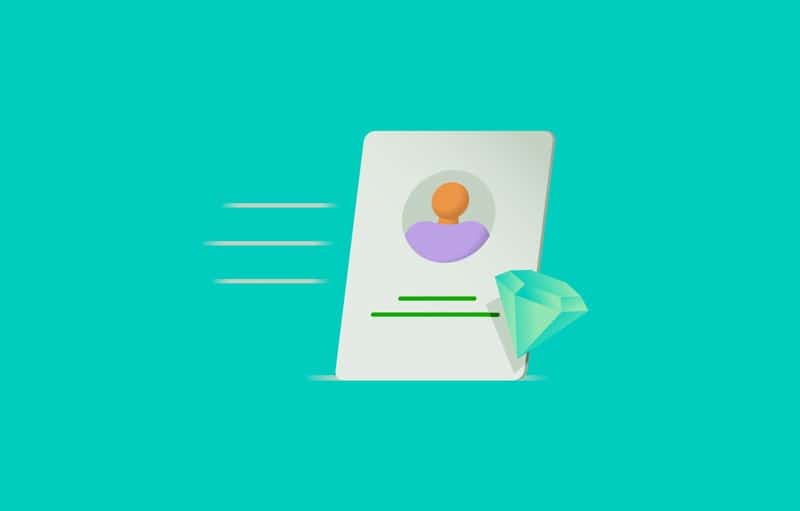
When you use Training’s work marketplace for your freelance business, you plant your business in an environment that’s purpose-built to connect you with potential long-term clients.
In other words, we’re committed to helping you succeed! We’ve designed Training so it’s easier for you to promote your most in-demand services, showcase your best work, embrace new client relationships with confidence, and watch your consistent efforts pay off.
How can you leverage all of this to your advantage? In this article, we’ll share best practices and resources to give you a solid foundation.
We’ve also turned to two experienced business owners to get their insights for independent professionals that are just starting out:
- Morgan Overholt, a freelance graphic designer who is the owner of Morgan Media LLC, a freelance coach, and the co-founder of TheSmokies.com.
- Peggy P., an editor and proofreader who had more than two decades of experience running her own business to draw on when she joined Training in 2019.
Ready to learn more about getting started on Training? Let’s begin by walking through each step of the sign-up process.
1. Go to Training.com and click on “Sign Up”
Start on Training by clicking on the “Sign Up” button in the top right corner.

2. Sign up using your work email address, Apple or your Google Account
You have a few options for your free account:
- If you continue with Google or Apple, you’ll use your existing account to login to the site. This means one less username and password to remember, and it extends any notifications you’ve turned on—like suspicious event detection—to your Training account.
- You can also use your preferred email address to create a unique login that isn’t directly connected to other services.
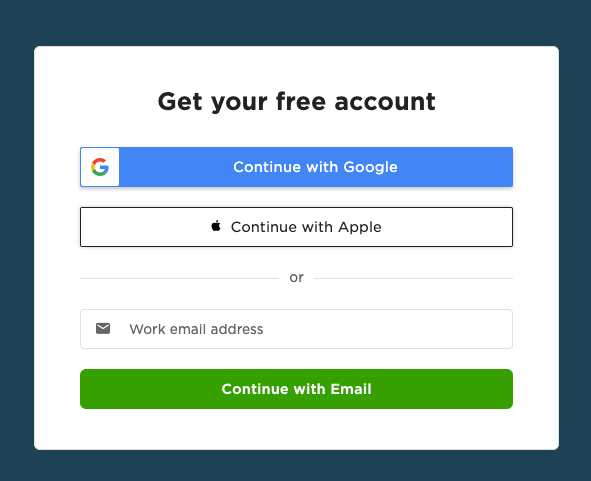
3. Add your personal information
Finish this first part of setting up your account by adding a few more details:
- Your first and last name
- A password for your account
- Your location
Indicate that you want to “Work as a freelancer,” decide whether you want to subscribe to our top tips, then hit the appropriate checkbox once you’ve reviewed the Training Terms of Service—including the User Agreement, and Privacy Policy.
We know: This information can be a lot to process. But its also critically important to your business and your success on Training. Get to know some of the highlights here.
Once you’re ready, click on Create My Account” to move on to the next part: Creating your Training profile.
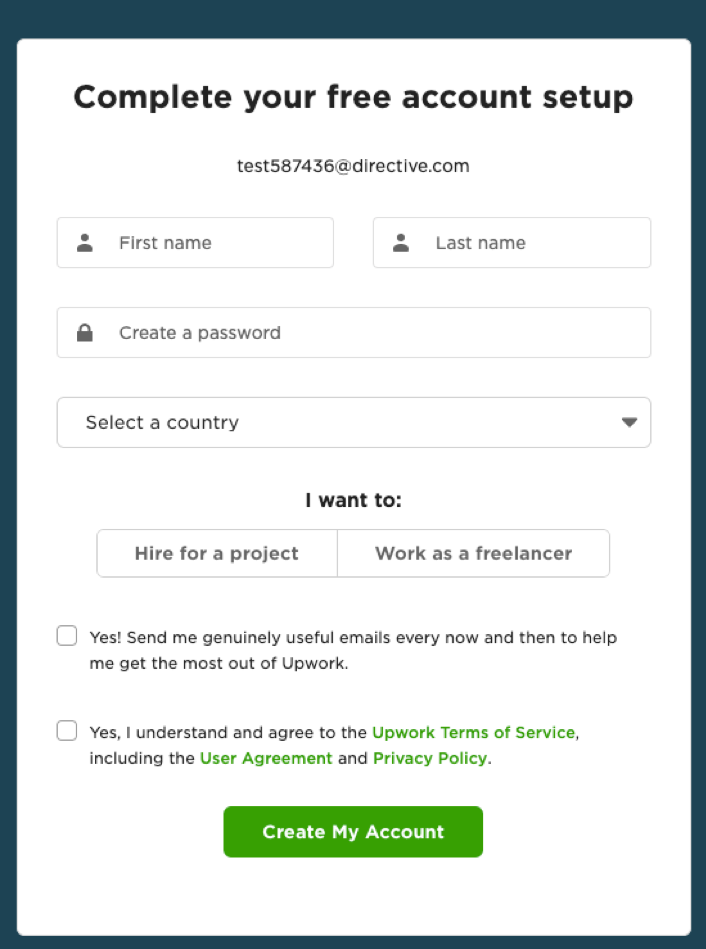
There are two ways to connect with clients on Training:
- They find you through your profile or in Project Catalog (a marketplace for projects you’ve predefined)
- You approach them by submitting a proposal for their job posting
In either situation, you need to have a freelancer profile that introduces your business, highlights your expertise, and captures their attention. Well dig deeper into your profile later—you can always come back to edit and refine it.
For now, let’s review the basic information you’ll want to include.
4. Start your Training profile by telling us about the work you do
Before you can start applying for job posts on Training, you need to complete at least 60% of your profile:
- A photo of yourself
- Your title
- Your overview
- Work history
- At least one skill tag
Of course, we recommend completing 100% of your profile! But you don’t need to do it all today. In fact, youll probably refine it on a regular basis.
“I’ve redone my profile probably 75 times,” Peggy said. “Within your own specialty, you need to position yourself according to what your market wants and cares about. That's why I keep editing my profile, even if I only change a sentence—it needs to be relevant to my prospective clients.”
The first two sections prompt you for information about the services you offer:
- Your overall category of work
- The particular skills you specialize in
- The level of experience you have
You can choose up to four work categories. We suggest picking the strongest, most specialized, and/or most in-demand. While the categories you select will impact how clients find your profile, you can apply to job postings in any category.
Highlight as many as 10 skills from Training's extensive list. As you start to type in a skill, Training will offer suggestions from a standardized list. These skills will show up on your profile—you can drag-and-drop them into the order you want—and help prospects understand whether you have the skillset their project needs.
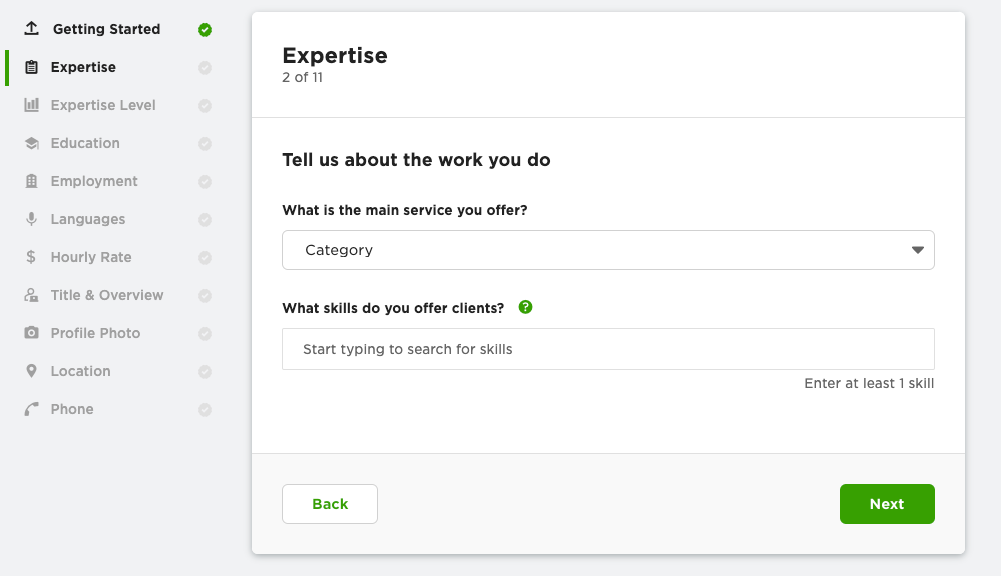
On the next screen, click on the option that most accurately describes your level of expertise: Entry level, intermediate, or expert.
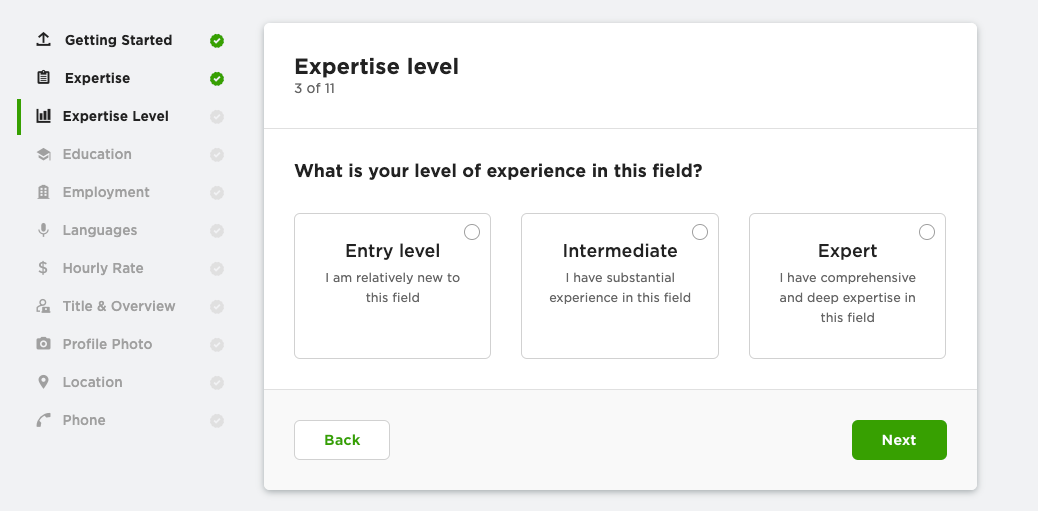 [Learn how to create a compelling freelancer profile]
[Learn how to create a compelling freelancer profile]
5. Highlight your educational background
This section summarizes your formal education. If you choose to add entries here, all the details are optional except the institution.
We suggest including:
- The degree earned, even if you haven’t completed it
- The area of study
- Additional details, such as awards or recognitions received, or extracurricular activities (i.e. teams, clubs) you were involved in.
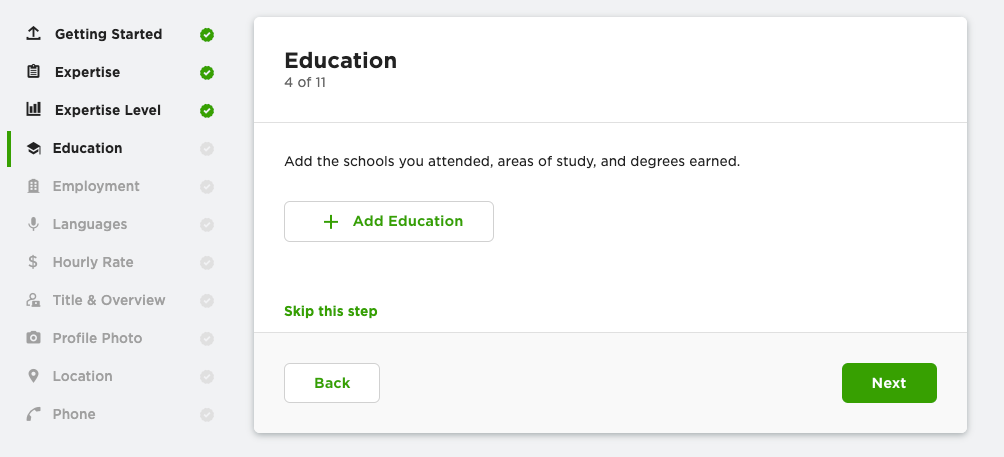
6. Highlight your past work experience
Your past work experience can help build credibility with a potential client—particularly when you’re new to Training. It can emphasize not just your level of expertise but industries or subjects areas you may already be familiar with.
You may want to include:
- Companies you’ve worked with in the past
- Projects completed before joining Training
- Projects you can share from other freelancing sites
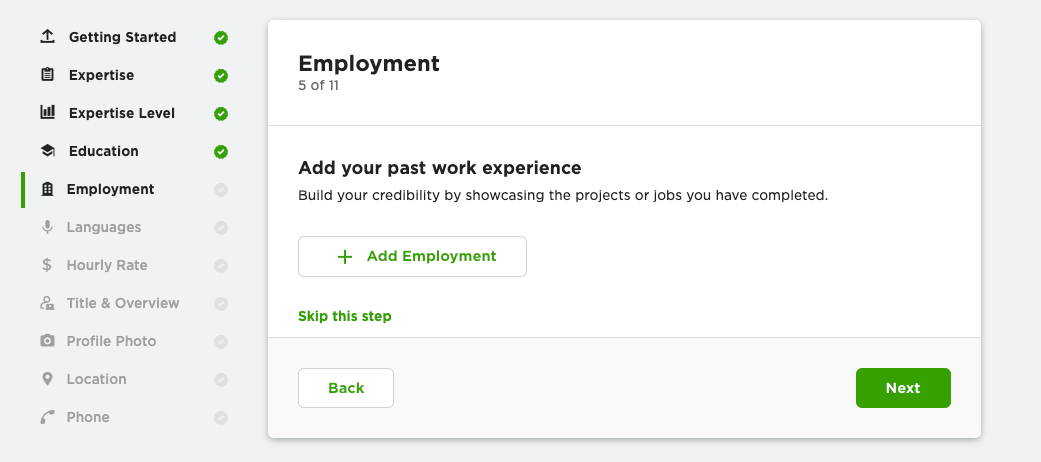
7. Add your language proficiency
Training operates in English and you’re required to indicate your English proficiency in your profile. But businesses on Training come from all over the world and often do business in other languages, so be sure to indicate any other languages you might speak.
While language skills are self-assessed, try to be as accurate as possible so you set the right expectation with potential clients.
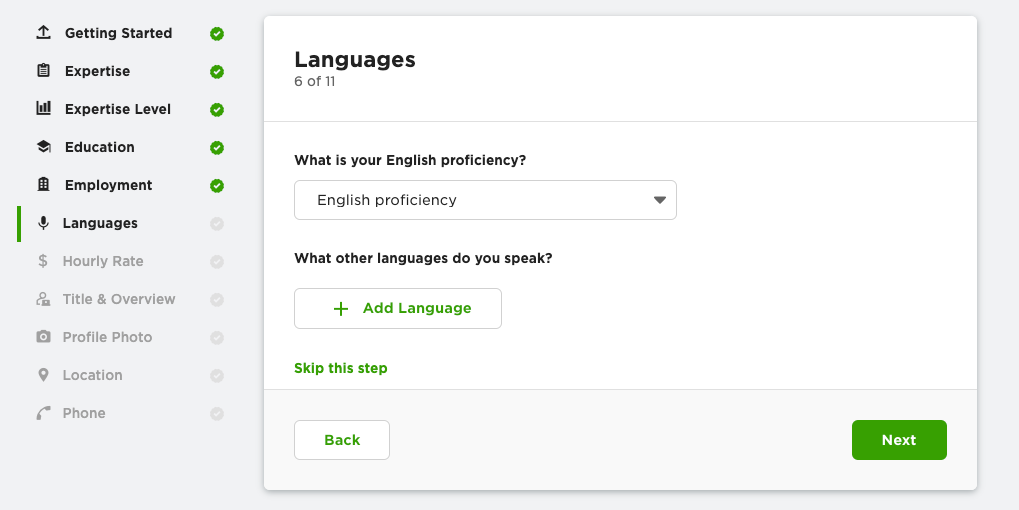
8. Set your hourly rate
If the question about setting your rates sparks anxiety, keep these two things in mind:
- You can adjust your overall rate at any time
- You can customize your rate every time you submit a proposal
One common mistake new freelancers on Training often make is to base their rate on their salary as an employee. While that may be a starting point, it doesn’t account for costs you’re now responsible for, such as equipment you rely on, your home office setup, taxes and professional fees, or ongoing skills training.
You may find it helpful to start at one rate then adjust it as you build your reputation through completed projects and client feedback, improve your understanding of the value you offer to long-term clients, and get a better sense of the effort each client project requires.
Learn more about Mistakes independent talent make when setting their rates—and ideas to fix them.
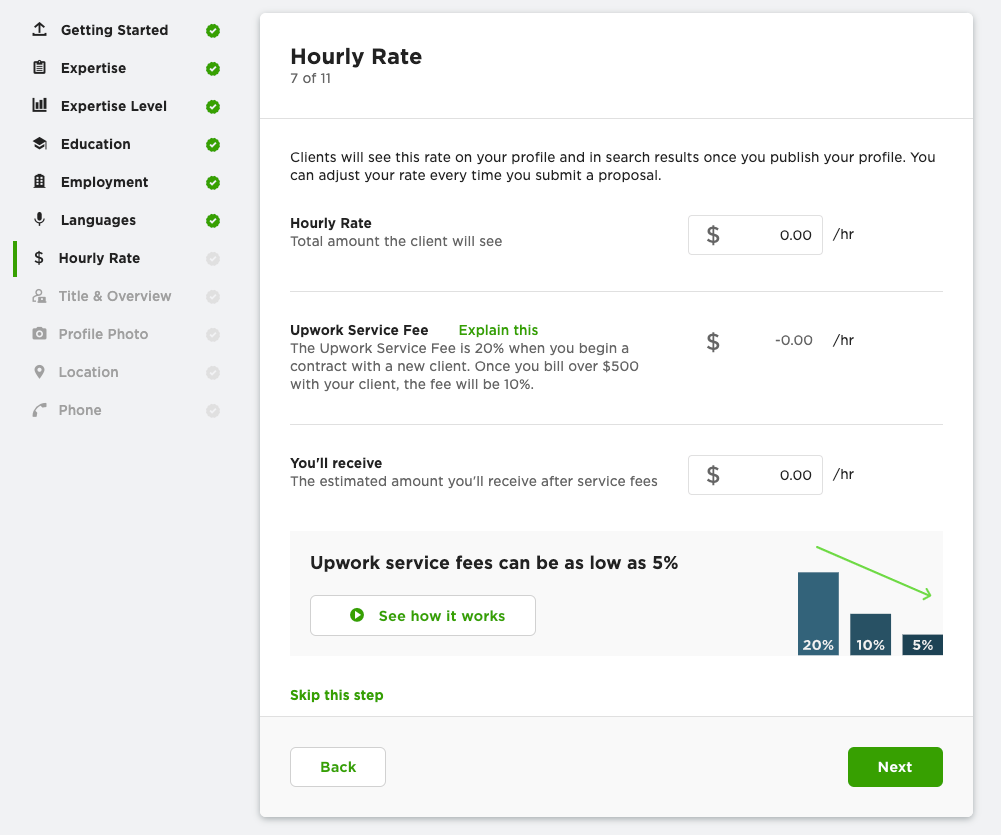
9. Indicate your title and overview
A great title and overview can make a difference to the responses you get from clients since theyre among the first things they will see. Let’s start by thinking about what clients will see in search results: Its basically an ad for your services.
What can you do to help entice potential clients to click through and look at your full freelancer profile? Here are a few ideas:
- Keep your title short. Get the most important information across as quickly as possible. Keep in mind that, on mobile search results, your title will trail off with a “...” after 35 characters or so.
- Be specific and include keywords that potential clients may search for.
- Make your first sentence count. Your whole bio can be a critical tool to convert new clients, but the very beginning will be the most visible.

In fact, while your overview can be up to 5000 characters, Overholt suggested keeping it to a few short paragraphs: “If the ‘read more’ option pops up, youve got too much,” she said.
Overholt has extensive experience not just as a freelancer but as a client who’s engaged other freelancers to bring her ideas to life. “I’ve hired freelancers with zero experience on the platform just because I was impressed by their portfolio and their bio,” she explained.
“Your overview should be one or two short paragraphs: This is my profession, this is how much experience I have, these are the kinds of projects I want to take on, this is what I can do for you. Short, sweet, and done.”
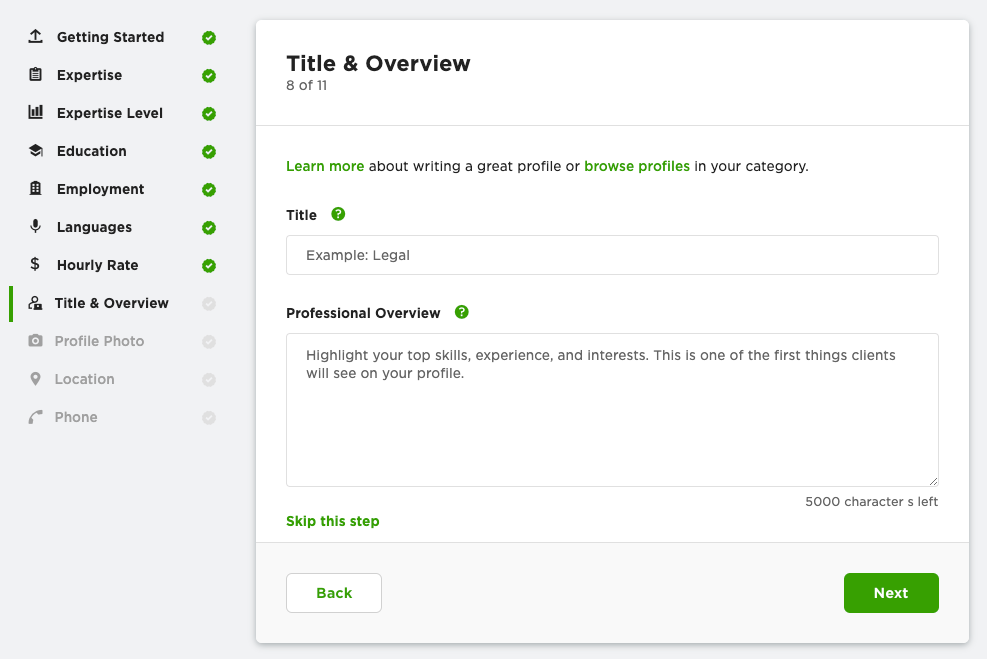
10. Add profile photo
Businesses want to work with professionals they can trust with critical work. Does your profile photo inspire confidence?
Training’s Terms of Use include a few requirements for profile photos. For example:
- It can’t be blank
- Your face must be clearly visible
- You can’t use a logo or caricature
Your photo doesnt need to be professionally taken. But how can you ensure you have a high-quality image? Check out ourhow-to guide for your perfect profile picture for professional tips and examples.
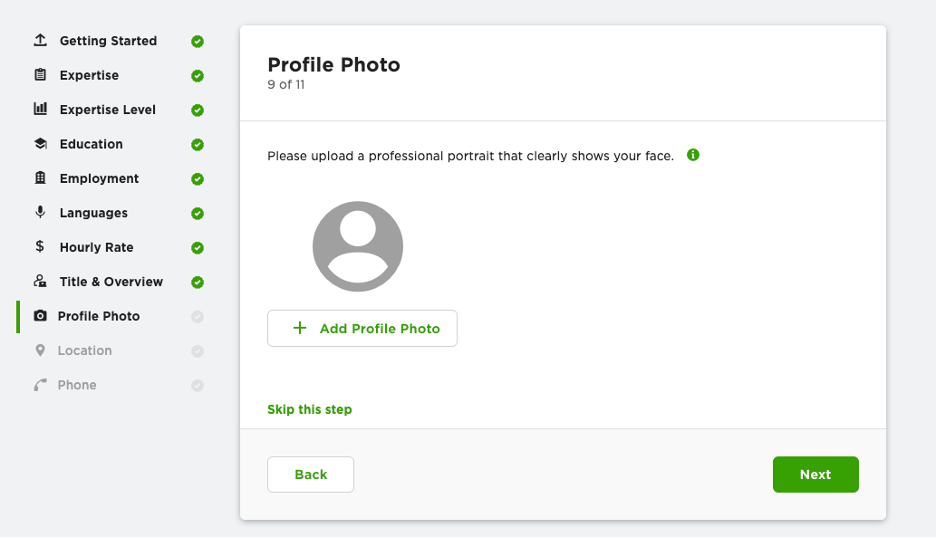
11. Add your contact details
You shared your location earlier in the sign-up process but now we need a bit more detail to help verify your identity, including your address and phone number.
And if you’re travelling or are otherwise not currently at home? Enter the address you use for tax purposes.
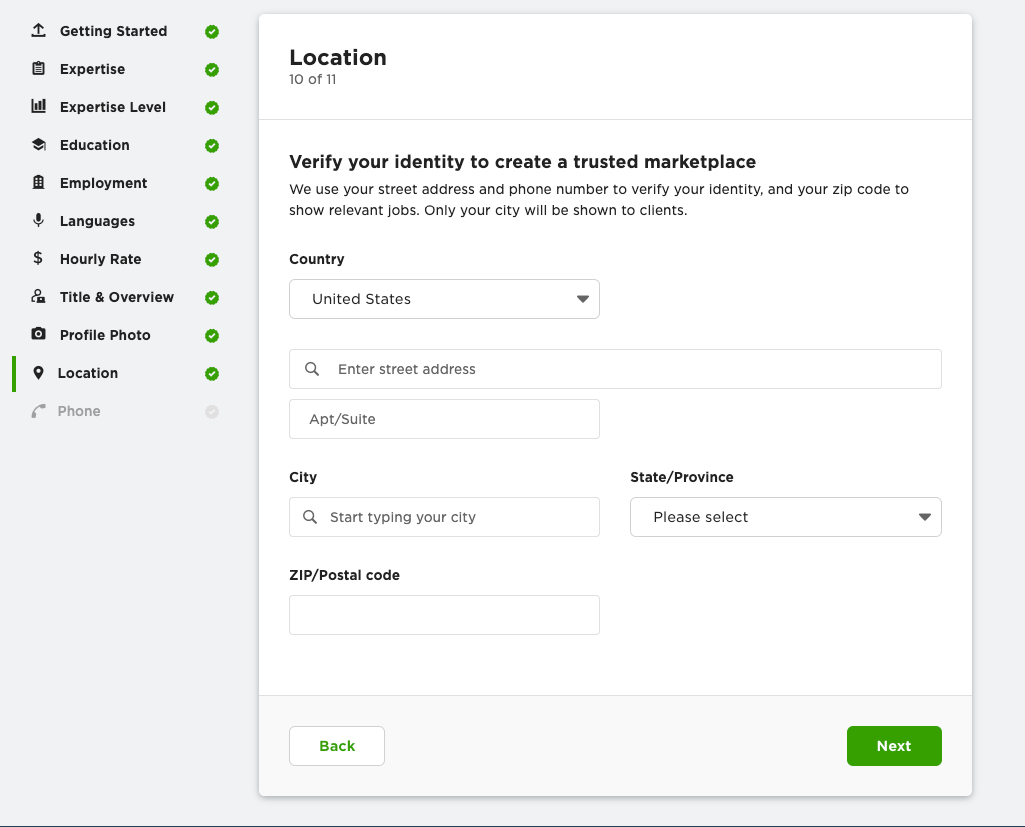
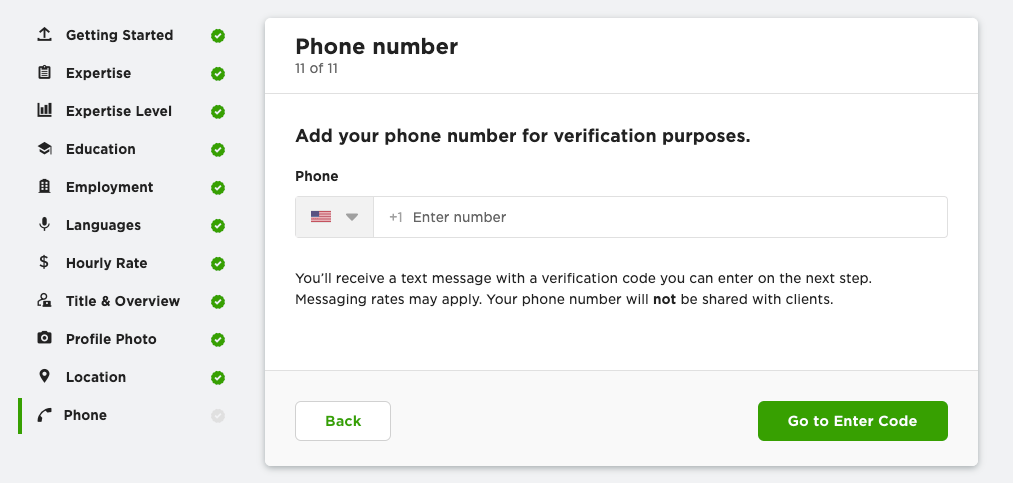
12. Preview your profile before submitting
You’re just about finished! Review your freelancer profile information one more time before submitting it.
A very important note: You wont be able to start submitting proposals right away.
Trust is essential on Training and it’s important that people are who they say they are. Before you can apply to any projects, youll need to verify your identity using:
- Valid government-issued ID
- An online visual verification
In most cases, this process takes about 10 minutes—just follow the prompts in your account. Click here to learn more about the verification process.

13: Become a freelancer on Training
Ta-da! With your Training account set up, youre ready to start working toward your first project.
In the next section, we’ll share best practices to help you make a first impression that wins new projects.
Top tips when getting started as a freelancer on Training
Right now, your focus is getting your first job on Training—so lets start there. In the next few sections, we’ll consider profiles, proposals, and interview preparation.
Then we’ll have a quick look at the long view: How to keep your skills sharp as your business grows.
Create a profile that stands out
As mentioned earlier, at least 60% of your profile needs to be completed before you can start submitting proposals for job posts on Training.
Not only does a fully-completed profile help clients get a full picture of your experience, it also helps Training match you with more relevant projects.
And a completed profile is required if you want to achieve Rising Talent status or become a Top Rated freelancer—both of which can help you build a stronger reputation on Training.
From the work category you choose to the overview section you write, use every part to emphasize your skills and position yourself as a professional. And don’t overlook the importance of your online portfolio.
One of the first things Overholt said she looks at is a portfolio, particularly when it comes to creative skills, such as writing and design. Too often, she said, freelancer portfolios include just a couple of work samples—and it isn’t enough.
I think I have something like 30 to 40 different examples available in my portfolio,” she said. This variety serves two purposes:
- Clients want to see if you have experience in their industry or have worked on projects that are similar to theirs. More examples means more opportunities for them to see this overlap.
- It gives clients a better understanding of the variety of work you do. You may understand that logos and brochures take the same skill setbut a potential client may not.
“We all start somewhere, and you may need to fake it until you make it,” she said. “ I started with no portfolio: I did work for family and friends, I did work for myself. Those are the projects I used until I became a more seasoned freelancer.”
Want to learn more?
- Get more ideas on how to create a more successful freelancer portfolio
- Push your profile to the next level with an intro video60 seconds (or less) to show prospects who you are and what you do.
- Find more in-depth suggestions about creating a freelancer profile that stands out.
Create winning proposals
Getting new clients starts with your proposal and cover letterand that means figuring out what it takes for you to get their attention.
“When I post a new project as a client, I can get anywhere from 10 to 50 submissions,” said Overholt. “Clients don’t have time to read through every proposal, they fly through them. You’re trying to quickly stand out in a pool of 50 other professionals and that can be intimidating!
Be brief. Freelance writer Andreea-Lucia Mihalache found that she got the best results when she kept her proposal to the point.
In How to Create a Proposal That Wins Jobs, Mihalache explained how she created a short proposal template and why she customizes it every time. “You have just a few seconds to win your client’s attention,” she said.
Focus on the client. Peggy said it’s important to keep your focus on the client rather than on you. “One piece of advice I took to heart is to use the word ‘you’ more than the word I’, and remembering that stops me,” she said. “In a cover letter, Ill tell a prospective client that ‘your job caught my eye,’ rather than ‘I am this and I am that’.”
Be strategic with your efforts. Danny Margulies, a freelance copywriter and client on Training, recommends taking what he calls the “upside-down proposal” approach.
This refers to the proposal process on Training: If a client asks additional questions as part of their job post, your responses will actually be shown at the top of your submission.
Answer the additional questions [first], put a lot of good, juicy nuggets in there, demonstrate your knowledge, demonstrate your caring to clients in those additional questions, and then move on to your cover letter,” he suggested in Power Proposal Tips to Help You Get Noticed.
Be careful not to overpromise. To help protect your reputation on Training, Peggy said, it’s important to set the right expectations.
You might read a proposal and think, ‘I can probably do that.’ Then you oversell yourself to the client to get the project,” she said. “If you can’t deliver, you could end up in a mess with a negative rating.”
Get prepared for interviews
To ace your next client interview, there are a few key suggestions to think about:
- Be as professional as you would be in person, such as showing up on time and dressing appropriately
- Study the job post and be prepared to ask thoughtful questions
- Learn as much as possible about the client ahead of time
Researching the client can be tricky if they haven’t provided any information in their job post—but don’t give up too easily:
- Look at feedback from other freelancers they’ve worked with. Do they include names or mention anything about the business?
- Does the job post mention the client’s industry or customer? Even if you dont know who the client is, getting more context about the project can be an advantage.
The reality is, if you get your proposal, profile, and online portfolio rightor if you offer a packaged service on Project Catalog—you may not do an interview.
“My speciality is somewhat unique and I’ve been hired many more times than I’ve been interviewed,” Peggy said. “From my experience, if a client has reached the point of sending me a message, I often get the job.”
Stay patient when trying to land your first client
When you’re new to Training, one of the most important things you can do is get to know the rules of Trainingso you don’t inadvertently break them—and to figure out how the work marketplace can work for you.
“When I first joined Training, I had a few people contact me with what was likely a scamthose are the kinds of things you avoid by following the rules and understanding why theyre in place, Peggy said.
“Its tempting to just jump in,” she added. “But even with my previous experience, I had to build my business on Training brick by brick. If you’re new to Training and new to having your own business, there’s a whole world of information to learn, from marketing yourself to getting paid to paying taxes.”
And there are a lot of resources available through Training:
- The Talent Resource Center, where youll find articles, videos, ebooks, and more to provide you with insights, information, and inspiration.
- Training Help, where you’ll find hundreds of how-to articles so you can navigate different features and functionalities.
- The Training Community, where you can connect directly with other freelancers.
“The thing that I did right when I first started? I paid attention to people who’d been in my shoes and succeeded, not the ones who tried and failed,” said Overholt.
I found top rated freelancers who’d earned $100k or $200k on Training and read their blogs and followed their advice, she said. “There are so many people succeeding who are happy to share what they know. You just need to talk to us!”
Find more tips to help you grow your business in How to Get More Jobs on Training.
Continue updating and improving your skills
One thing you’ll quickly learn about running a business is that being proactive pays off, whether that’s thinking about your next project, following trends in your industry, or keeping your expertise sharp.
Independent talent may enjoy an edge over employees when it comes to up-to-date skills: They’re nearly twice as likely to have completed skills training in the last six months.
So, as you start to carve out your new routine as a business owner, consider including time for regular research and learning. Check out top tools independent talent can use to keep their skills fresh for ideas.
Next Step
That’s a lot of information to take in! We hope it brings you more confidence as you get started freelancing on Training and your new independent life. If you’re not yet a freelancer on Training, sign up for an account today.
Author Spotlight
Amy Sept
Writer & Editor
Amy Sept (@amysept) is an independent writer, editor, and content marketing strategist who’s dedicated to helping businesses of all sizes navigate the future of work. As a Canadian military spouse and slow traveller, she has a lot of hands-on experience with remote work, productivity hacks, and learning how to "go with the flow."




